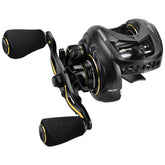
How to choose and When to Use Ice Fishing Line
Choosing the right ice fishing line for a given situation is paramount to your success while ice fishing. Ice fishing line needs to be the appropriate size for fish you are targeting, plus be able to "work" whatever bait or lure/jig you are using. It's not always about just using a tip-up, as a lot of anglers use spinning reels and conventional reels like the new KastKing Kestrel Elite Magnesium Frame BFS Finesse Baitcasting Reel! But regardless of what reel you are using, if you do not have the correct ice fishing line, your ice fishing time will be very disappointing. Let's see if I can help guide you to successful ice fishing by helping you choose the "right" ice fishing line.

Fishing Line Type
There are four types of fishing lines you can use while ice fishing. Monofilament, KastKing's new TriPolymer, fluorocarbon and braid. Let's take a look at the four.

Monofilament fishing line has been around forever and is probably the most durable of the four. The TryPolymer is too new to possibly out-shine, mono, but we will see. Monofilament fishing line stretches more than the other three, making it the least sensitive. Although the least sensitive, it is also the most forgiving. Monofilament line is also visible in the water.
TryPolymer fishing line – the new kid on the block – TryPolymer, to put it simply is a blend of three different nylons that make up the line through the proprietary triple cross head extrusion process. The line stretches less than fluorocarbon, but yet is more durable than monofilament. It is also less visible in the water. To me, and I cannot wait to try it this winter, the TryPolymer may be my new go-to line when ice fishing.
Fluorocarbon fishing line that you would use for ice fishing has limited stretch, making it extremely sensitive when trying to detect subtle bites, but it also is susceptible to breaking off easier. Fluorocarbon, even with some negatives is a solid choice for ice fishing. It offers zero visibility, and for its pound test and lack of stretch, make it a good choice.
Braided fishing line has zero stretch and is the most sensitive, but I feel braid could have issues with colder – frozen waters in the way of retaining water, hence freezing in the guides or on the reel could occur. If the air temperatures are above 25, or if you are in an ice shanty, braid gets the nod, but you absolutely need to have a fluorocarbon leader as braid is extremely visible in the water, and fish will definitely shy away from any offering you have in the water.
What Size Line?
For ice fishing line, pound test is more a personal touch, than an absolute. However, with that being said, most ice anglers I know, including myself, use 4 to 6-pound test. Believe it or not, you can land larger fish on this light line. For one, winter fish are much more lethargic and do not fight near as hard as they would if the water temperatures were a lot higher. The second key to lighter pound test lines is the ability of the drag to work well. Choosing a reel with a quality drag is critical. If you are using a tip-up, the process of hand lining the fish to the hole is critical, and must be done slowly.
Although most anglers use lighter line in the 4 to 6 pound class, when targeting pike or the likes, you may want to up the ante slightly to 10-pound test.

Heavier lines can be used when ice fishing but bear in mind, there needs to be a balance between its ability to work the lure or bait properly if needed, or not be like a "stick" in the water and have some supple-ness to it. I would almost never go heavier than 8 to 10-pound test on the monofilament, TryPolymer or fluorocarbon side due to its increased diameter and ability to remain supple in cold water and air conditions. With braid, and if the weather is above 25 degrees, or you are in an ice hut with heat, you could use 15 to 20-pound test due to its smaller diameter. In spite of its smaller diameter, braid retains water, which if lying on the ice, could freeze up on your reel. Even with the braid, always use a leader of 4 to 6-pound test, with some anglers opting for even lighter leaders of 3 and 2!
The Options are Limitless
Pick up any catalog that offers ice fishing line and you will see the options are limitless. All the top line manufacturers make a line designed just for ice fishing. KastKing, although not by name, has several lines I feel will work very well on the hard water. As I said above, the new TryPolymer is definitely one to reckon with, while Sufix, Berkley and Seaguar also make great lines for ice fishing.
When choosing the line, know what reel you will be using. Know what lures or bait as well. If you make sure to choose a line that will work well in the colder confines, your ice fishing days will be successful.












